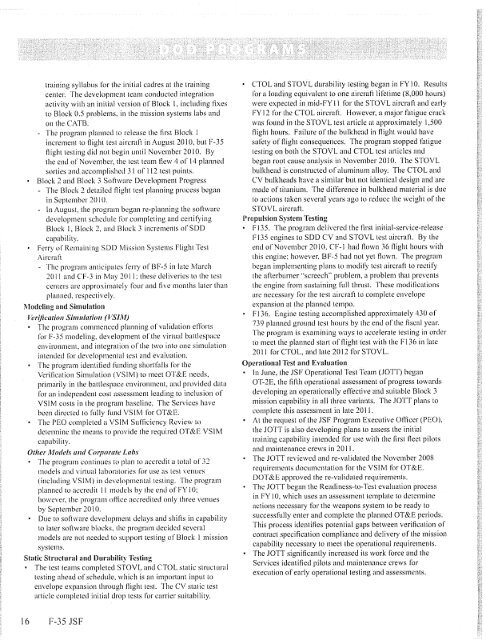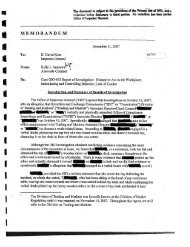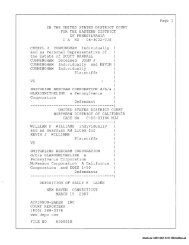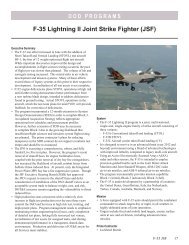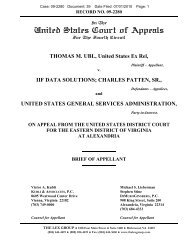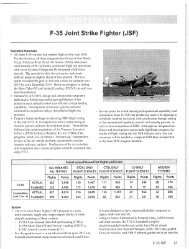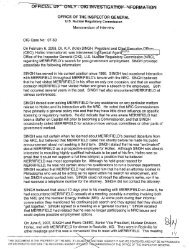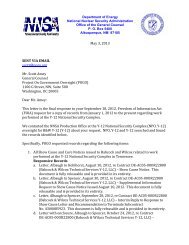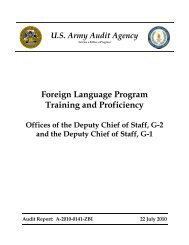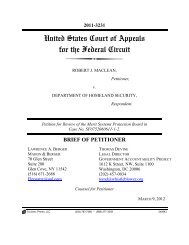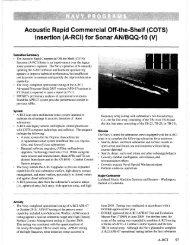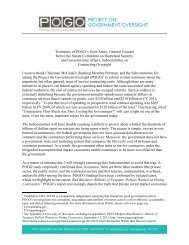F-35 Joint Strike Fighter (JSF)
F-35 Joint Strike Fighter (JSF)
F-35 Joint Strike Fighter (JSF)
You also want an ePaper? Increase the reach of your titles
YUMPU automatically turns print PDFs into web optimized ePapers that Google loves.
training, syllabus for the initial cadres at the training<br />
center. The development team conducted integration<br />
activity with an initial version of Block 1, including fixes<br />
to Block 0.5 problems. in the mission systems labs and<br />
on the CATB,<br />
The program planned to release the first Block J<br />
increment to flight test aircraft in August 2010, but. F-<strong>35</strong><br />
flight testing did not begin until November 2010. By<br />
the end of November. the test team flew 4 of 14 planned<br />
sorties and accomplished 31 of 112 test points.<br />
• Block 2 and Block 3 Software Development Progress<br />
The Block 2 detailed flight test planning process began<br />
in September 2010.<br />
In August, the program began re-planning the software<br />
development schedule for completing and certifying<br />
Block 1, Block 2, and Block 3 increments of SDD<br />
capabi 1 ity,<br />
• Ferry of Remaining SDD Mission Systems Flight Test<br />
Aircraft<br />
- The program anticipates ferry of BF-5 in late March<br />
2011 and CF-3 in May 2011: these deliveries to the test<br />
centers arc approximately four and five months later than<br />
planned, respectively.<br />
Modeling and Simulation<br />
Verification Simulation (VSIM)<br />
• The program commenced planning of validation efforts<br />
for F-<strong>35</strong> modeling, development of the virtual battlespace<br />
environment, and integration of the two into one simulation<br />
intended for developmental test and evaluation.<br />
• The program identified funding shortfalls for the<br />
Verification Simulation (VSIM) to meet OT&.E needs,<br />
primarily in the battlespace environment, and provided data<br />
for an independent cost assessment leading to inclusion of<br />
VSIM costs in the program baseline. The Services have<br />
been directed to fully fund VSIM for OT&E.<br />
• The PEO completed a VSIM Sufficiency Review to<br />
determine the means to provide the required OT&E VSIM<br />
capability.<br />
Oilier Models and Corporate Labs<br />
• The program continues to plan to accredit a total of 32<br />
models and virtual laboratories for use as test venues<br />
(including VSIM) in developmental testing. The program<br />
planned to accredit 11 models by the end of FY 10;<br />
however, the program office accredited only three venues<br />
by September 2010.<br />
• Due to software development delays and shifts in capability<br />
to later software blocks, the program decided several<br />
models are not needed to support testing of Block 1 mission<br />
systemic.<br />
Static Structural and Durability Testing<br />
• The test teams completed STOVL and CTOL static structural<br />
testing ahead of schedule, which is an important input to<br />
envelope expansion through flight test. The CV static test<br />
article completed initial drop tests for carrier suitability.<br />
16 F-<strong>35</strong> <strong>JSF</strong><br />
• CTOL and STOVL durability testing began in FY10. Results<br />
for a loading, equivalent to one aircraft lifetime (8,000 hours)<br />
were expected in mid-FY11 for the STOVL aircraft and early<br />
FY 12 for the CTOL aircraft, However, a major fatigue crack<br />
was found in the STOVE test article at approximately 1,500<br />
flight hours. Failure of the bulkhead in flight would have<br />
safety of flight consequences. The program stopped fatigue<br />
testing on both the STOVL and CTOL test articles and<br />
began root cause analysis in November 2010. The STOVL<br />
bulkhead is constructed of aluminum alloy. The CTOL and<br />
CV bulkheads have a similar but not identical design and are<br />
made of titanium, The difference in bulkhead material is due<br />
to actions taken several years ago to reduce the weight of the<br />
STOVL aircraft<br />
Propulsion System Testing<br />
• F1<strong>35</strong>. The program delivered the first initial-service-release<br />
Fl<strong>35</strong> engines to SDD CV and STOVL test aircraft. By the<br />
end of November 2010, CF-1 had flown 36 flight hours with<br />
this engine; however, BF-5 had not yet flown. The program<br />
began implementing plans to modify test aircraft to rectify<br />
the afterburner "screech" problem, a problem that prevents<br />
the engine from sustaining full thrust. These modifications<br />
are necessary for the test aircraft to complete envelope<br />
expansion at the planned tempo.<br />
• 1=136. Engine testing accomplished approximately 430 of<br />
739 planned ground test hours by the end of the fiscal year.<br />
The program is examining ways to accelerate testing in order<br />
to meet the !planned start of flight test with the Fl 36 in late<br />
2011 for CTOL, and late 2012 for STOVL.<br />
Operational Test and Evaluation<br />
• In June, the <strong>JSF</strong> Operational Test. Team (JOTT) began<br />
OT-2E, the fifth operational assessment of progress towards<br />
developing an operationally effective and suitable Block 3<br />
mission capability in all three variants, The JOTT plans to<br />
complete this assessment in late 2011.<br />
• At the request of the <strong>JSF</strong> Program Executive Officer (PEG).<br />
the JOTT is also developing plans to assess the initial<br />
training capability intended for use with the first fleet pilots<br />
and maintenance crews in 2011,<br />
• The JOT. T reviewed and re-validated the November 2008<br />
requirements documentation for the VSIM for OT&E.<br />
DOTE approved the re-validated requirements.<br />
• The JOTT began the Readiness-to-Test evaluation process<br />
in FY 10, which uses an assessment template to determine<br />
actions necessary for the weapons system to be ready to<br />
successfully enter and complete the planned OT&E periods.<br />
This process identifies potential gaps between verification of<br />
contract specification compliance and delivery of the mission<br />
capability necessary to meet the operational requirements.<br />
• The JOTT significantly increased its work force and the<br />
Services identified pilots and maintenance crews for<br />
execution of early operational testing and assessments.


